Intent Data
Introduction
Intent data is becoming an increasingly important tool among B2B organizations. According to a recent TOPO survey, 62% of companies are using one or more intent data solutions—up 29% from 2019 and 121% from 2018.1 And a recent Demand Gen Report survey confirms these findings, reporting that 85% of respondents are either currently leveraging or planning to leverage intent data.2
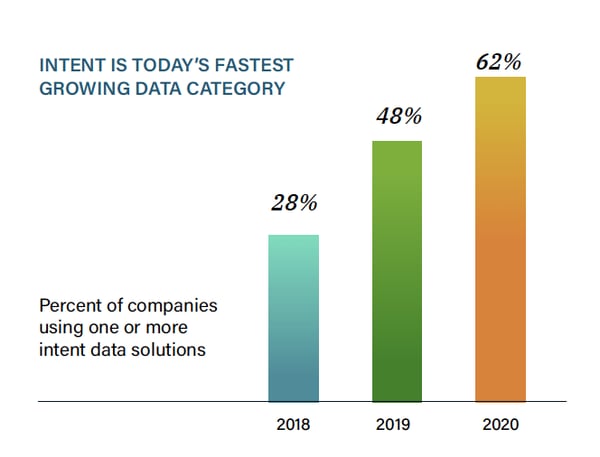
B2B organizations aren’t sticking to just one source of intent data, either. According to TOPO,

The rapid rise in intent data’s popularity is the result of numerous factors. For example, the B2B buying process has become quite complex, and business-facing companies increasingly require information that will help them better focus resources on the organization most likely to buy. Intent data provides exactly this type of information.
Via numerous use cases, intent data supports the entire customer lifecycle by adding focus and efficiency to marketing, sales, and customer success efforts. This especially true for B2B organizations employing account-based go-to-market strategies.
But before jumping into the individual use cases, it’s important to understand what intent data is (and isn’t).
What is intent data?
In general, intent data is any information generated by businesses’ online research and content-consumption activities. B2B marketing and sales teams use intent data to gain insights into which organizations are increasingly showing interest in specific products or services, and to what extent.
Intent data can be derived from first-party sources—such as your owned web properties—or via numerous types of third-party sources (see below). When intent data vendors discuss their data, they’re usually referring to the latter; though, some intent data providers, for example Intentsify, provide first-party intent tracking solutions as well.
Why is intent data important to B2B sales and marketing organizations?
The B2B buying process is becoming increasingly difficult. The typical buying group involves six to 10 decision makers. And according to Gartner, each decision maker is armed with four or five pieces of independently gathered, often conflicting information.4 Deconflicting this information to arrive at a consensus among a large group is a complicated, arduous, and unenjoyable endeavor. In fact, Gartner research shows “77% of B2B buyers state that their latest purchase was very complex or difficult.”5
B2B marketing organizations that help their prospects navigate buying-process complexities win. As a recent LeadMD survey report states, “B2B buyers want straight-forward, no BS messaging that tells them how your product or service will help them. They want you to understand their circumstances and be direct.”6
This, however, isn’t nearly as easy as it may seem.
The buying process comprises numerous stages and the journey is anything but linear. More than just understanding the buying stages and how to support prospects’ efforts to navigate them, B2B marketers must have the right strategies, resources, and information needed to aid their prospects.
Intent data provides marketers and sellers with a view into the various challenges and needs of their target buyers, enabling them to supply prospective buyers with the information they need, when they need it.
Intent data benefits
Intent solutions provide B2B marketers with greater efficiency as time, energy, and resources are more quickly allocated to the right accounts, using the right messages. Consequently, marketing teams benefit from greater target-account engagement, better return on media spend, higher lead-conversion rates, and increased marketing-influenced sales pipeline.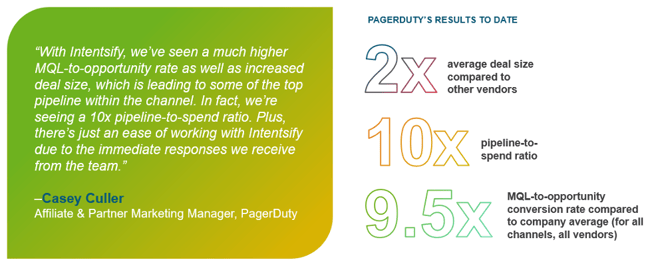
Similarly, sellers benefit from higher quality leads, with whom they can have more productive conversations—since the data identifies the issues and solutions prospects are most concerned with. This then translates to improved prospect experiences, increased closed-won rates, and higher average deal size.
Not to be forgotten, customer success team also gain much value from intent data. Intent signals can show customer success managers which current accounts are ripe for expansion or at risk of churning. This allows enables customer success teams to do their jobs more effectively—instead of having to react quickly to customer conversations, they can get ahead of both the problems and opportunities.
Intent data use cases
While awareness of intent data and its benefits for B2B organizations has grown rapidly in recent years, the full range of its use cases still remains vague to many. Many B2B marketing teams see intent data as merely a tool for serving account-targeted display ads. While for B2B sales teams, intent data usually conjures simple images of lead or account prioritization. These use cases are important, but they represent only a few of the many ways in which B2B businesses can leverage intent data to drive efficient growth.
Intent data supports every stage of the demand funnel, from top-of-funnel brand awareness campaigns to post-sale customer success efforts. B2B organizations that invest in third-party intent data should strive to gradually expand its use throughout the entire funnel. Here is a list of the key intent use cases.
Digital advertising
One of the most popular B2B marketing use cases, intent data improves digital-ad campaign performance by allowing digital marketers to identify and serve impressions to businesses that are actively researching relevant challenges, solutions, products, services, and brands. In effect, this improves return on ad spend (ROAS) while also supporting account-based marketing and selling efforts throughout the demand funnel.
Third-party demand generation
Serving ads to target accounts is valuable, especially from a branding perspective. However, such account-based ad campaigns rarely result in the volume and type of account engagement (e.g., inquiries, leads, contact information) needed to hit sales pipeline goals. For this reason, it’s smart to leverage intent data to drive your third-party demand generation campaigns as well (especially with regard to content syndication).
Many demand generation vendors, media partners, and publishers allow marketers to target specific accounts on a cost-per-lead (CPL) basis. This ensures you’re not wasting media budget on leads outside your ABM program’s targeting parameters. Combined with intent data—which highlights the accounts actively researching your products or services—you gain a powerful, efficient demand gen solution for your ABM programs.
Event planning
Intent data can help your demand generation and field marketing teams plan better in-person events. Its ability to identify locations comprising large groupings of prospective accounts showing interest in your products and/or services results in higher attendance rates and more meaningful conversations at the events.
Moreover, intent data will identify the specific topics and/or keywords target accounts are actively researching. With this information, marketing teams can further boost turnout by customizing emails and advertisements according to prospects’ research interests. This leads us to the next under-recognized use case...
Content marketing
The right intent data can tell you the product and service categories target accounts are actively researching, as well as if they’re researching competitors’ offerings. This then allows you to tailor content to target accounts at any stage of the demand funnel. From selecting the right content syndication assets, to routing leads to the most relevant email tracks and customizing sales pitch decks, intent data can guide your content creation to ensure the best possible engagement outcomes.
Account prioritization and lead scoring
Whether you’re looking to generate engagement among a specific target-account list (TAL) for ABM programs or among any account fitting your ideal customer profile (ICP), intent data helps marketing and sales teams focus time and resources on the accounts and leads most likely to be “in market” to buy. Prioritizing accounts based on their content-consumption behaviors is far more effective than simply targeting accounts on a sales team wish-list. Similarly, adding intent insights to your lead scoring methodology helps ensure marketing only sends over the highest quality leads to sales. From these insights come the precision, efficiency, and effectiveness ABM strategies promise to provide, while also ensuring higher conversion rates for lead-volume-based demand strategies.
Sales enablement
Much like with content marketing, intent data helps sellers better understand the specific challenges and solutions prospects are most concerned with. Armed with this information, BDRs and sales reps can tailor their outreach efforts and conversations. For example, if intent data shows that a certain prioritized account has been researching a competitor’s offering, you can then customize your pitch deck to highlight your solution’s strengths over the competition’s. This results in much more productive interactions with prospects.
Customer retention and expansion
This is perhaps the most underutilized intent data use case. A major focus of most B2B businesses is ensuring customers remain customers to expand their investments (this is especially true of businesses that sell SaaS). By monitoring the research activity of current accounts, intent data helps customer marketing, sales, and customer success teams identify which customers are most likely to churn, as well as those ripe for cross-sell.
For example, being informed when one of your customers is actively researching a competitor’s offering is incredibly valuable; it lets your team address existing customer issues before it’s too late. On the other hand, if the data shows certain customers researching solutions you offer—but they haven’t yet bought—you can reallocate resources to expand their investment and increase lifetime value.
With so many use cases, it’s easy to go too big, too fast with intent data. The possibilities are enticing. Yet, it’s a good idea to initially focus on one or two use case that will drive quick results. After you’ve dialed in those initial use cases, you should gradually expand to the others.
The various types of intent data
Many types of intent data exist. They all provide glimpses into what accounts are currently researching—and to what extent. Some intent sources offer broad coverage across a wide range of web properties, delivering a high-level view of what many businesses are currently researching. Other types provide a more granular, nuanced picture of fewer businesses’ research behaviors. Some types derive signals from a business’ first-party interactions, while others aggregate data across a cooperative of third-party web properties. Some focus on content consumption among walled gardens of owned properties, others gather data among public domains.
Here’s a quick breakdown of the more common types of intent data:
First-party intent data
This is content-consumption and website-engagement data gathered from your organization’s owned web properties. It may be “known” data (e.g., when a user fills out a form) or anonymous data (e.g., tracked via cookies or another method). As such, it can be highly granular, providing many types of intent signals. However, since it requires prospects to first arrive at your web properties, its coverage is very limited.
Third-party intent data
This intent data is gathered and provided by vendors which track intent-derived activities on third-party web properties. These typically come in four flavors: exchange data, co-op data, publisher data, and public/social data.
-
Exchange data: Intent data gathered via ad exchanges across biddable online advertising inventory, which allows for unmatched coverage and volume of data, but often with less analytical depth (though this is not always the case). Intent scores are typically based on keywords but can also include topics assigned to web pages by natural language processing (NLP).
-
Natural language processing (NLP): A subset of artificial intelligence (AI) focusing on interactions between human (natural) languages and computers. Specifically, programming computers to process large amounts of language data.
-
-
Co-op data: Co-op data is gathered from a collective of online properties owned by publishers, research firms, tech vendors, agencies, event firms, and more. Intent scores are typically based on topics assigned to specific web pages. This data is often more nuanced than exchange data, but with less coverage and data volume (though it offers greater coverage than standalone publisher data).
-
Publisher data: A type of intent data collected exclusively from a publisher’s own portfolio of web properties. It can be high quality, but often lacks the coverage (e.g., lower volume of signals, fewer businesses tracked) of exchange-based and co-op data due to fewer overall web properties available to monitor.
- Social/public data: This data is derived by combining the public web (e.g., social media websites) to show you which of your target accounts are engaging with competitors, specific keywords, and events relevant to your product and service offerings. Unlike all the other types, social/public intent data is less about content consumption and more about engagement activities—which makes it very valuable. Further, it offers great coverage due to the nearly ubiquitous use of social media among businesses and business leaders. However, its intent insights are less granular than some of the other types.
There isn’t a single right way to derive intent data. Each method holds its own benefits that complement shortcomings of the others. In fact, accessing a range of intent data sources is the best way to ensure you get both the broad and in-depth intent insights you need to focus your efforts on the right organizations, providing them with the information they need, when they need it.
Monitoring topics vs. monitoring keywords
Almost all third-party intent providers derive intent by measuring content consumption around either topics or keywords. Understanding the differences between these two tracking methodologies is critical to ensuring the successful use of your intent data investments.
The strengths and weaknesses of keyword tracking
Keywords look for the use of specific words or phrases within a piece of content. What’s great about monitoring keywords is that it allows you to track whatever keywords and/or combination of keywords you’d like. This is especially helpful when trying to identify a target account’s interest regarding niche solutions.
Further, it’s a dataset that can be customized to each organization, unique to your specific needs. Whereas topics are preset according to a taxonomy leveraged by many other organizations, keywords can be customized to the strengths and weaknesses of your business, your competitors’ brands, and their solutions. It provides a one-of-a kind dataset specifically for you.
Used alone, however, tracking keywords doesn’t account for the contextual relevance of the entire piece of content being consumed. For example, say you’re interested in identifying companies looking to buy a financial technology (fintech) solution. One webpage may discuss the stock market value of a specific fintech company and another page may contain an article ranking the best fintech solutions. Monitoring keywords alone may weight a user’s visit to each site equally, based on the number of mentions of “financial technology” and “fintech.” Yet, the article ranking fintech solution is obviously more important when assigning an intent score to the company consuming the content.
The strengths and weaknesses of topic tracking
Monitoring topics is much better about ensuring the contextual relevance of the content being consumed. Such relevance is typically identified using machine learning, such as natural language processing (NLP).
NLP is subfield of computer science and linguistics that focuses on the interactions between computing and human language. More specifically, NLP is how we program computers to process and analyze large amounts of human language data.
Using topics is valuable for preventing “false positive” intent signals. As in the example provided above, monitoring the topic of “fintech” or “financial technology” would consider the context of each page, and therefore give more weight to the article discussing the best fintech solutions.
Another great benefit of monitoring topics is that, using NLP, this method enables further segmentation, allowing intent data providers to delineate pieces of content by the extent of their relevance. For example, Intentsify’s proprietary feed provides customers with intent insights for topic-based activities and the corresponding buying stage for each signal. The latter measures target-accounts' consumption of content that has been scored and identified with Intentsify’s methodology as relevant to either early or late research activity, including the extent to which the consumed content mentions specific products or competitors (which are typical of late-stage content), and tracks how that changes over time. This often helps marketers understand where target accounts are in their path to purchase so that they can better select follow-up tactics and messaging.
However, when monitoring topics, you must rely on a preset topic taxonomy to select from. A lot of analysis goes into understanding which webpages are relevant to specific topics, which means it can’t be done in real time.
Instead, intent data providers offering topic-based intent must gradually expand their taxonomy. All this means you usually must stick to broad topics, preventing your ability to track companies’ research into niche solutions or less-known brands.
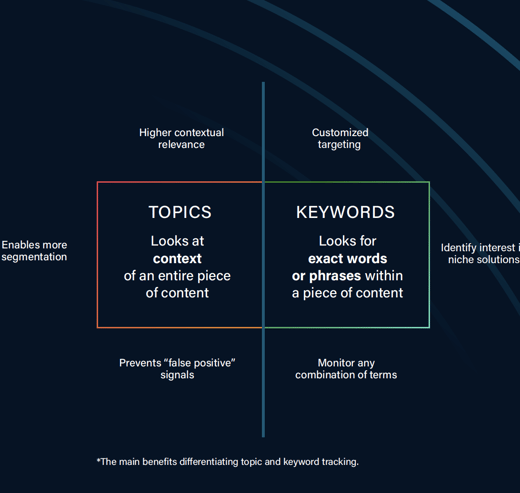
Using topics and keywords together allows for contextual relevancy and specificity
The optimal course of action is to monitor both specific keywords and topics. You can then layer the findings of both types of signals to identify the companies exhibiting the strongest intent to buy.
Today's intent data challenges and opportunities
All the varying types of intent data and intent-derivation methodologies present a great opportunity for B2B organizations. Properly pieced together, marketing, sales, and customer success teams gain a holistic, granular view of their target market and customer needs.
Unfortunately, all the various sources and types of intent data remain largely fragmented. Each intent feed only provides B2B organizations with a quick snapshot of prospective buyers’ research activities. Consequently, intent data siloes prevent the full view of the market landscape.
Because each data source monitors intent signals captured across differing web properties using differing methodologies, they’re each only capable of providing information from a very specific angle. In the words of Kathy Macchi, VP of Consulting Services at Inverta:
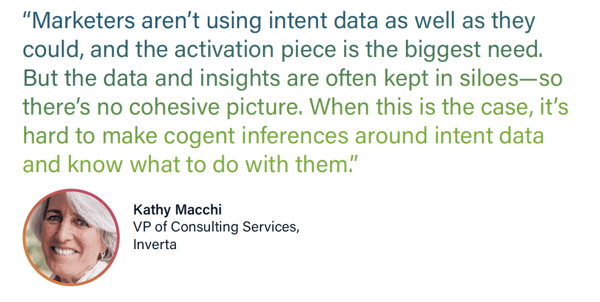
It’s important to put this in the real-world context of today’s B2B buying committees. An eight-person committee will comprise numerous roles across several teams, each with their own goals, challenges, needs, and concerns. It’s unlikely an IT director on a buying committee is consuming the same content as a sales VP—or even researching the same problem.
Now add to these variables the vast range of ways individuals conduct research based on their own preferences: white papers, blog posts, webinars, review sites, analyst reports, case studies, etc.—each catering to specific departments, if not specific roles. The result is a ton of differing intent signals. Accessing only a small percentage of them through a single intent data feed can skew insights in an unhelpful way.
Reaping the full benefits of intent data requires aggregating multiple feeds to provide broad coverage and verify the strongest signals.
To be sure, verifying intent signals is key. It’s like the difference between having one or several key witnesses in a criminal trial. Even if several intent sources monitor the same web properties, they each use different scoring methodologies, meaning their results may differ significantly. If two or more intent sources highlight the same signals, it’s a substantially stronger indication of buying intent.
However, most B2B marketing teams are ill-equipped to properly aggregate, digest, and act on insights compiled across multiple intent data sources. A recent TOPO survey and subsequent webinar substantiate this finding. TOPO analysts explain that while B2B marketing teams are rightly investing heavily across diverse intent data sources, the No.1 challenge marketers face with their intent data investments is “Making intent data actionable.” In fact, 67% of those surveyed acknowledged having this challenge, exceeding the No.2 challenge by more than 22 percentage points.
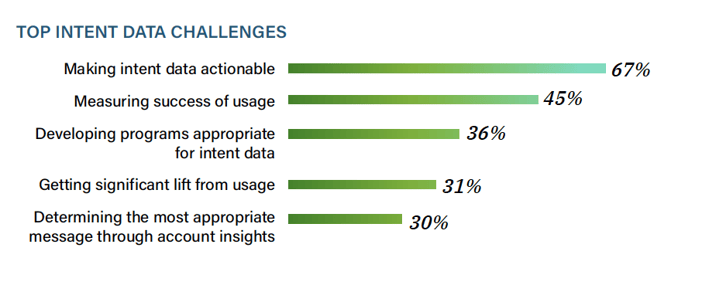
Intent data should be used as a foundational B2B marketing resource, supporting nearly all activities, from top-of-funnel brand awareness to post-sale account expansion. Instead, the value of intent data often remains hamstrung by activation difficulties.
What is Intent Activation?
The intent data category has grown rapidly in recent years. But while many intent data providers strive to explain why their data is superior to competing sources or types, which are typically complementary, the bigger problems remain:
- Each intent feed only provides a piece of a confusing picture, preventing the full, accurate view B2B marketers need to support buyers’ needs by getting the right information to the right individuals when they’re ready for it.
- Acting on intent signals remains tedious; marketers can’t easily digest all the data, verify the signals, draw decisive conclusions, and distribute the insights across all the teams responsible for acting on it.
Intent activation is ready for a new category of intent-focused technology designed to tackle these challenges. Specifically, Intentsify’s Intent Activation technology is focused on achieving two primary objectives:
- Layer numerous, complementary intent feeds into a broader and more precise picture of target-buyer needs, amplifying the most valuable intent insights; and
- Make it simple for B2B marketers to act on the insights across several key use cases.
Much of this vision has been accomplished. Intentsify’s software automates the aggregation and digestion of numerous intent data sources, providing a more holistic and granular view of target-account research activities. Further, we currently offer two intent-activation solutions for programmatic advertising and lead generation.
A once tedious workflow has become an efficient, effective way to quickly adjust demand generation efforts according to changing market needs. And customer benefits are numerous:
- Increased ROI on intent data investments
- Greater marketing efficiency—time, energy and resources are more quickly allocated to the right accounts, using the right messages, which leads to…
- Better prospect experiences, increased engagement, improved engagement quantity and quality, higher conversion rates, and greater customer retention and expansion, which lead to…
- A jump in marketing’s contribution to pipeline, and sales’ strengthened confidence in marketing, which leads to…
- More customers and revenue
[1] TOPO, Intent Data Market Guide Webinar, May 19, 2020: https://webinars.topohq.com/intentdataguide/
[2] Demand Gen Report, Intent Data: It’s Becoming a Key Ingredient for Revenue Growth, p.3.
[3] TOPO, Marketing Technology Survey Report: Executive Summary, p.5.
[4] https://www.gartner.com/en/sales/insights/b2b-buying-journey
[5] Ibid
[6] LeadMD, B2B Buyer Sentiments: Key takeaways and findings on COVID-19’s impact on buying habits and perception in B2B buyers; p.6.


